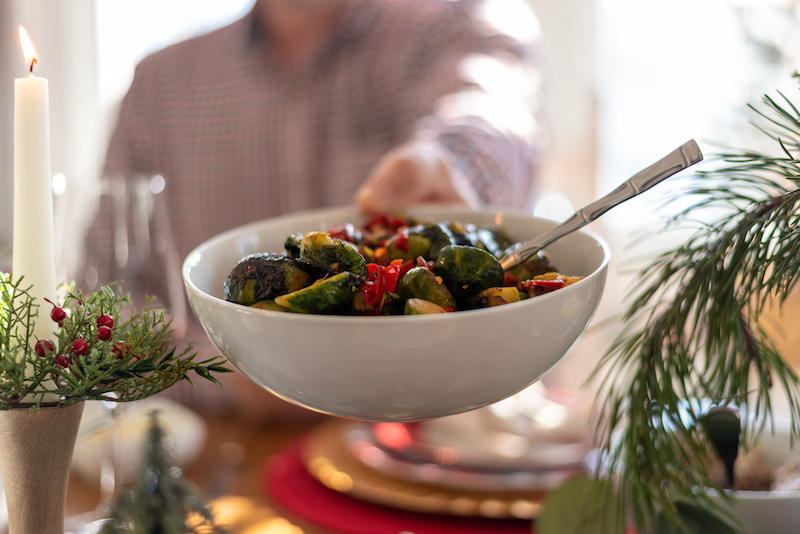Who doesn’t love the holidays—the laughter, music, time spent with friends and family, and the foods that are so tempting and delicious… but not necessarily nutritious. These foods surround us at parties and family gatherings. They lurk in our refrigerators and under plastic wrap on our countertops. What better reason to study up on healthy holiday eating tips?
Regardless of your age, holiday food presents you with choices that are not always the best for you. But not all holiday eating is forbidden. The question is, how do we enjoy these foods without abandoning our health goals?
10 Healthy Holiday Eating Tips
- Focus on weight maintenance. If you’ve recently been trying to lose weight, aiming to maintain through the holidays is a realistic goal that still allows you to enjoy your favorite seasonal indulgences. You can then return to your pre-holiday efforts without feeling like you missed out.
- Stay on a schedule. When you are on a healthy eating schedule, your body adjusts to your new routine and may rebel if you snack outside of normal times.
In addition, doesn’t it seem that holiday food is particularly known to invite nibbling throughout the course of a day? Thirty minutes after eating, if you hear yourself saying, “Just two more cookies won’t hurt,” stop and ask yourself if you are actually hungry. If you’ve always used the holidays as an excuse to overeat, it’s likely a habit you can work on breaking!
Also, don’t skip a meal or healthy snack to try to make up for the additional calories. Eat if you are hungry, or you could end up overeating to compensate for that extra hunger.
- Plan your menu to include healthy items. If you’re the one preparing holiday foods, include plenty of fruits, vegetables, lean meats, seafood, whole grains, and low-fat dairy items. For healthy appetizers, whole-grain crackers with reduced-fat cheese, vegetables with a low-fat yogurt dip, or fresh fruit skewers are great.
In preparing foods, use chicken stock, fat-free yogurt, light cream cheese, and low-fat milk in place of high-fat ingredients whenever possible. Substitute nonfat yogurt or applesauce for oil in baked goods.
- If you have to snack, choose nutritious foods. If you are attending a gathering where the food is prepared by someone else, nibble on some of the healthier and leaner foods first to reduce the amount of heavy, more calorie-dense food items you consume overall.
For example, shrimp cocktail is an ideal dish to snack on. Shrimp are low in calories and high in protein. Ten shrimp are approximately 40 calories and .44 grams of fat. And the protein in shrimp will help keep you full so you’ll eat less overall and take in fewer calories. A quarter-cup of cocktail sauce adds 50 calories. However, that amount of sauce can contain 600 mg of sodium—one-fourth of the recommended daily requirement. You might want to reach for a yogurt sauce or avocado-based dip instead.
- Eat more slowly.Take at least 20 minutes to consume a plate of food. Take breaks in between bites to be more present in the moment and engaged in conversations. This also gives your stomach time to tell your brain that you have had enough. And in observance of this rule, don’t use the biggest plate you can find and pile it high with food. I bet you’d be surprised at how much food would still leave you satisfied!
- Leave room for dessert. Make decisions based on what you want to eat. If you’ve been waiting all year for holiday dessert, skip the extra helping of dressing or mashed potatoes, and enjoy the dessert.
- Drink water. Avoid high-sugar drinks. Water avoids all calories and is good for you. It will also help you feel satisfied and cut cravings.
- Don’t forget to exercise. Holiday preparations and scheduling can make sticking to an exercise routine a challenge, but it is important to keep the momentum going. Stopping temporarily may make it mentally tougher to start over again after the holidays.
If you need to, break your 30-minute daily walk into three 10-minutes walks. Your strength training may devolve into doing some knee bends after rising from a chair, and a quick set or two of lifting a pair of dumbbells a few times every other day. The idea is to do enough to keep yourself toned, burn some calories, and feel better after eating richer foods.
If you are making holiday preparations, you are probably moving more often than you normally do, so you don’t always have to complete your full exercise routine — balance is key.
- Get an adequate amount of sleep. Insufficient sleep can make it hard to manage blood sugars. Also, when you are sleep-deprived, you tend to eat more and prefer high-fat, high-sugar foods because your body is craving energy. Aim for seven to nine hours of sleep per night.
- Don’t make food the sole focus. While the food is enjoyable, remember the holidays are about sharing time with family and friends. Tell stories, play games, sing songs. Don’t make holiday eating the main attraction in your celebrations. As food diminishes in emphasis, you’re less likely to overindulge in it.
Foods and Drinks to Avoid for Healthy Holiday Eating
Sherbet floating in a sea of fruit juice and lemon-lime soda is not good for you due to its high-sugar content. Enjoy a small cup if you love this drink; otherwise, leave it at the beverage table.
Alcohol is often mixed with butter, cider, and sweetener, loading a beverage with calories. It can also increase hunger.
Hot cocoa is often filled with added sugar, and the sugar levels are increased even more with whipped cream and marshmallows. You might want to pass on store-bought hot chocolate and make your own with unsweetened cocoa powder, low-fat milk, and some vanilla. Garnish with a cinnamon stick.
Eggnog is packed with calories—one cup contains 343. If you stir in alcohol, the calorie count goes even higher.
Holiday pie crusts are loaded with butter or shortening and bulged with sugary fillings. The number one offender? Pecan pie; at 500 calories and 27 grams of fat per slice. And that’s before adding ice cream or whipped cream topping. Pumpkin pie is a far healthier choice at around 225 calories and 6 grams of fat per slice.
Cranberry sauce. Cranberries require a lot of sugar to sweeten them. As a result, one cup of the sauce has 413 calories. One cup of unsweetened applesauce next to your serving of turkey adds only 102 calories.
Bottom Line
The holidays are a time of celebration— and are special occasions to enjoy some foods you wouldn’t (or shouldn’t) consume on a regular basis.
Enjoy yourself, but maintain some balance when determining what you are eating and drinking. Look for ways to incorporate healthy foods and stay physically active. You’ll actually feel better both during and after the holidays by exercising some control during your celebrations and following these holiday eating tips.
To find more tips on healthy eating, take a look at our Health & Wellness blog.
Want to find out more?
If you’d like to stay up to date with Bethesda Health Group, sign up here to receive our blog and newsletters!
"*" indicates required fields
Related Articles
Want to find out more?
If you’d like to stay up to date with Bethesda Health Group, sign up here to receive our blog and newsletters!
"*" indicates required fields



